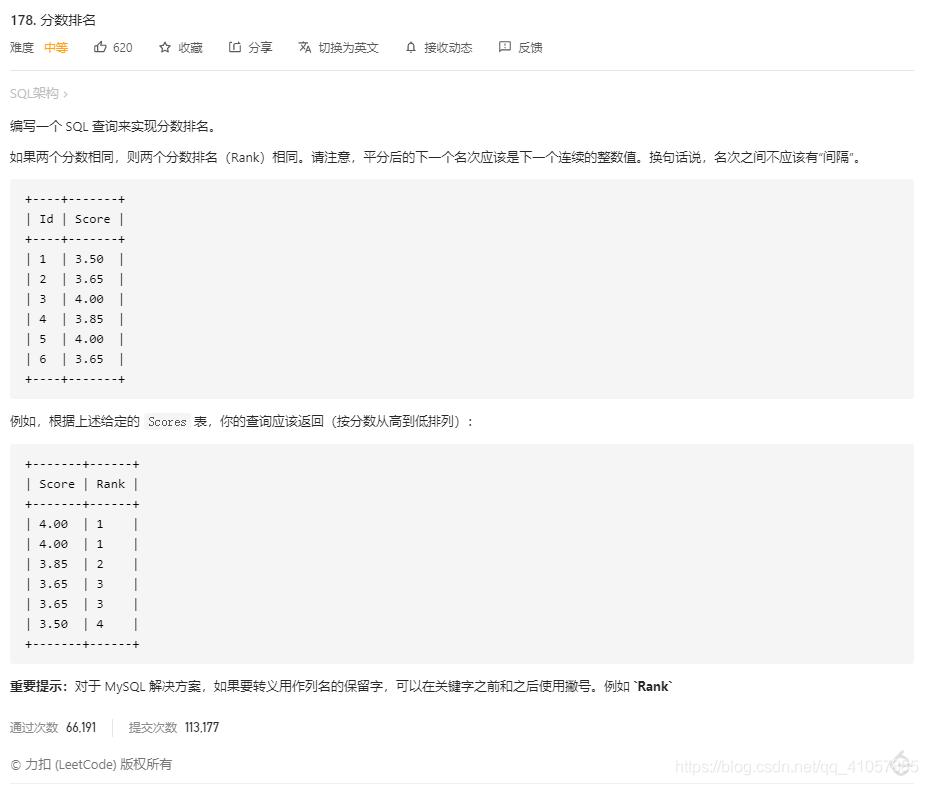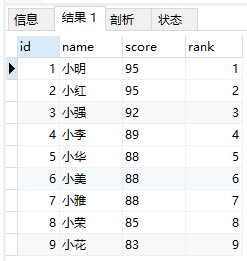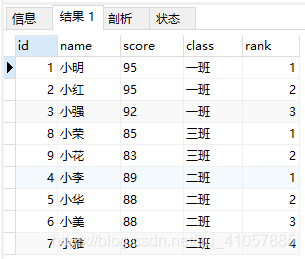 Database
Database
 Mysql Tutorial
Mysql Tutorial
 How to use rank() over, dense_rank() over and row_number() over in MySQL
How to use rank() over, dense_rank() over and row_number() over in MySQL
How to use rank() over, dense_rank() over and row_number() over in MySQL

For the above question, if you do not use the function used this time, the answer is as follows. In other words, if your MySQL cannot use the function in this article, you can pass the following grammatical logic for replacement.
SELECT t1.Score as Score, ( SELECT COUNT(DISTINCT t2.Score) FROM Scores t2 WHERE t2.Score >= t1.Score ) AS `Rank` FROM Scores t1 ORDER BY t1.Score DESC
rank() over (business logic)
Function: Ranking after finding out the specified conditions. If the conditions are the same, the rankings will be the same, and the rankings will be discontinuous.
This function can be used for student ranking, where two students with the same grades will be tied, and the next student will vacate his due position. That is: 1 1 3 4 5 5 7
SELECT id, name, score, rank() over(ORDER BY score DESC) AS 'rank' FROM student

Function: Find out the specified Those after the conditions are ranked. If the conditions are the same, the rankings are the same. The rankings are discontinuous. Note: It has the same effect as rank() over, the difference is that dense_rank() over ranking is dense and continuous. Use this function to determine a student's ranking. In the event of a tie, two students will be tied for the same ranking, and the next ranked student will be determined based on the next ranking. That is: 1 1 2 3 4 5 5 6SELECT id, name, score, dense_rank() over(ORDER BY score DESC) AS 'rank' FROM studentCopy after login

Function: Find out Ranking is performed after specifying conditions. If the conditions are the same, the rankings will be different, and the rankings will be discontinuous. Even if the queried values are the same, this function will sort them continuously without considering whether they are parallel. That is: 1 2 3 4 5 6SELECT id, name, score, row_number() over(ORDER BY score DESC) AS 'rank' FROM studentCopy after login

The business logic in the function can be complex and is not limited to ORDER BY, you can also add PARTITION BY.### 分班级排名 SELECT id, name, score, class, row_number() over(PARTITION BY class ORDER BY score DESC) AS 'rank' FROM studentCopy after login
The above is the detailed content of How to use rank() over, dense_rank() over and row_number() over in MySQL. For more information, please follow other related articles on the PHP Chinese website!

Hot AI Tools

Undresser.AI Undress
AI-powered app for creating realistic nude photos

AI Clothes Remover
Online AI tool for removing clothes from photos.

Undress AI Tool
Undress images for free

Clothoff.io
AI clothes remover

AI Hentai Generator
Generate AI Hentai for free.

Hot Article

Hot Tools

Notepad++7.3.1
Easy-to-use and free code editor

SublimeText3 Chinese version
Chinese version, very easy to use

Zend Studio 13.0.1
Powerful PHP integrated development environment

Dreamweaver CS6
Visual web development tools

SublimeText3 Mac version
God-level code editing software (SublimeText3)

Hot Topics
 1379
1379
 52
52
 MySQL: Simple Concepts for Easy Learning
Apr 10, 2025 am 09:29 AM
MySQL: Simple Concepts for Easy Learning
Apr 10, 2025 am 09:29 AM
MySQL is an open source relational database management system. 1) Create database and tables: Use the CREATEDATABASE and CREATETABLE commands. 2) Basic operations: INSERT, UPDATE, DELETE and SELECT. 3) Advanced operations: JOIN, subquery and transaction processing. 4) Debugging skills: Check syntax, data type and permissions. 5) Optimization suggestions: Use indexes, avoid SELECT* and use transactions.
 How to open phpmyadmin
Apr 10, 2025 pm 10:51 PM
How to open phpmyadmin
Apr 10, 2025 pm 10:51 PM
You can open phpMyAdmin through the following steps: 1. Log in to the website control panel; 2. Find and click the phpMyAdmin icon; 3. Enter MySQL credentials; 4. Click "Login".
 How to create navicat premium
Apr 09, 2025 am 07:09 AM
How to create navicat premium
Apr 09, 2025 am 07:09 AM
Create a database using Navicat Premium: Connect to the database server and enter the connection parameters. Right-click on the server and select Create Database. Enter the name of the new database and the specified character set and collation. Connect to the new database and create the table in the Object Browser. Right-click on the table and select Insert Data to insert the data.
 MySQL: An Introduction to the World's Most Popular Database
Apr 12, 2025 am 12:18 AM
MySQL: An Introduction to the World's Most Popular Database
Apr 12, 2025 am 12:18 AM
MySQL is an open source relational database management system, mainly used to store and retrieve data quickly and reliably. Its working principle includes client requests, query resolution, execution of queries and return results. Examples of usage include creating tables, inserting and querying data, and advanced features such as JOIN operations. Common errors involve SQL syntax, data types, and permissions, and optimization suggestions include the use of indexes, optimized queries, and partitioning of tables.
 How to create a new connection to mysql in navicat
Apr 09, 2025 am 07:21 AM
How to create a new connection to mysql in navicat
Apr 09, 2025 am 07:21 AM
You can create a new MySQL connection in Navicat by following the steps: Open the application and select New Connection (Ctrl N). Select "MySQL" as the connection type. Enter the hostname/IP address, port, username, and password. (Optional) Configure advanced options. Save the connection and enter the connection name.
 Why Use MySQL? Benefits and Advantages
Apr 12, 2025 am 12:17 AM
Why Use MySQL? Benefits and Advantages
Apr 12, 2025 am 12:17 AM
MySQL is chosen for its performance, reliability, ease of use, and community support. 1.MySQL provides efficient data storage and retrieval functions, supporting multiple data types and advanced query operations. 2. Adopt client-server architecture and multiple storage engines to support transaction and query optimization. 3. Easy to use, supports a variety of operating systems and programming languages. 4. Have strong community support and provide rich resources and solutions.
 How to use single threaded redis
Apr 10, 2025 pm 07:12 PM
How to use single threaded redis
Apr 10, 2025 pm 07:12 PM
Redis uses a single threaded architecture to provide high performance, simplicity, and consistency. It utilizes I/O multiplexing, event loops, non-blocking I/O, and shared memory to improve concurrency, but with limitations of concurrency limitations, single point of failure, and unsuitable for write-intensive workloads.
 MySQL and SQL: Essential Skills for Developers
Apr 10, 2025 am 09:30 AM
MySQL and SQL: Essential Skills for Developers
Apr 10, 2025 am 09:30 AM
MySQL and SQL are essential skills for developers. 1.MySQL is an open source relational database management system, and SQL is the standard language used to manage and operate databases. 2.MySQL supports multiple storage engines through efficient data storage and retrieval functions, and SQL completes complex data operations through simple statements. 3. Examples of usage include basic queries and advanced queries, such as filtering and sorting by condition. 4. Common errors include syntax errors and performance issues, which can be optimized by checking SQL statements and using EXPLAIN commands. 5. Performance optimization techniques include using indexes, avoiding full table scanning, optimizing JOIN operations and improving code readability.




